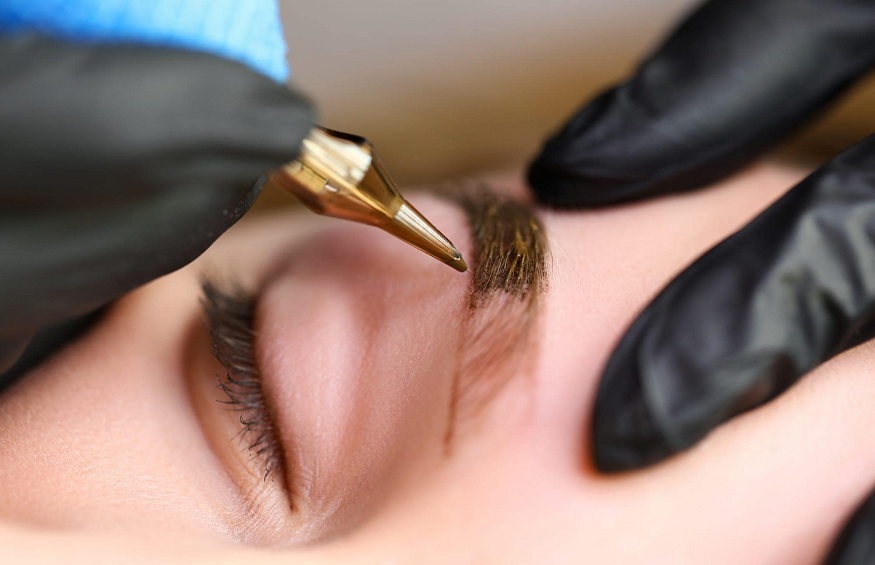Anyone who was a little too rough with the tweezers as a child or born with barely-there brows can benefit from a new fashionable treatment that promises more prominent, bolder brows: Eyebrow Embroidery in 3D.
The procedure has gained popularity in Malaysia and Singapore over the previous decade and is only now gaining traction in the United States. Also called “cosmetic tattooing,” “semi-permanent makeup,” “pigment embroidery,” “3-D eyebrow embroidery,” or “microblading,” it is a type of cosmetic tattooing (in case you want to do a thorough google search). The labels, however, are somewhat deceiving – it is not what you would generally identify with eyebrow makeup.
It is essentially a type of tattooing, but the method includes implanting pigment beneath the skin’s surface with tiny disposable needles in a pattern that resembles hair strokes. It’s designed to provide the look of natural thickness and fullness to thin brows.
I asked Shaughnessy Keely, one of the world’s top microblading experts, what she thought people should know before getting the treatment. After all, “one must never underestimate the power of the forehead,” as Jack Black famously stated.
Almost everyone can do it.
Any male or female client who has had hair loss due to Alopecia, chemotherapy, Trichotillomania (hair-pulling condition), or just over-tweezing is a good candidate for microblading. Anyone on Accutane or any blood-thinning medicine, as well as anyone pregnant or nursing, should avoid microblading.
It necessitates some planning.
Because the treatment is semi-permanent, it’s critical to understand what you’re getting into before you start. So do your homework and pick an artist whose work you know you like and with whom you feel at ease. To aid in the design process, Keely suggests bringing in a few reference photographs and selfies of how you generally style your brows.
You’ll Need To Prepare Your Skin
The artist must work with your skin in its most natural form to achieve the greatest results. Avoid excessive sun exposure in the days leading up to your visit because your artist will need to work with your skin in its most natural state. Please wait at least three days before your appointment if you usually get your brows threaded, waxed, or coloured. Arrive at your appointment well-rested, hydrated, and, most importantly, not hungover!
It Makes Use Of Your Current Brows
Many people believe they must shave or remove their current brow hair before the treatment, but this is not the case. “Although this would undoubtedly be the case with a typical body tattoo,” adds Keely, “we maintain and include as much of the natural brow hair as possible.” “If necessary, we will simply remove any hairs that fall outside of our final shape.”
It will take a few hours.
According to Keely, the first and most significant stage in the procedure is settling on a brow shape. Because it is semi-permanent, selecting something you will enjoy and want to maintain for a long time is critical. After determining the shape, the artist applies numbing lotion to the area around the brows, and the microblading process begins. The full consultation, including all prep work, takes approximately 2-3 hours on average. However, the actual microblading process takes 45 minutes to an hour, depending on the job.
It is not painful.
Before beginning the microblading procedure, the artist will apply numbing lotion to your brows to reduce pain. “Most of our customers relate it to threading or tweezing,” Keely explains. “Awful but bearable!”
It has a very long lifespan.
Because the procedure is performed within your skin’s superficial layers, it can last up to two years. After that, Keely suggests scheduling annual checkups to keep things looking clean and new.
There Are Some Dangers
Microblading, like any other form of tattooing, comes with some hazards. To keep yourself safe, observe pre- and post-care guidelines and proper hygiene when washing and touching your face. Also, seek a sterile salon that exclusively uses single-use, disposable needles and materials. Allergic reactions and irritations to the procedure are extremely rare but occur in extreme cases. Therefore, Keely advises speaking with a doctor before undergoing the treatment.

